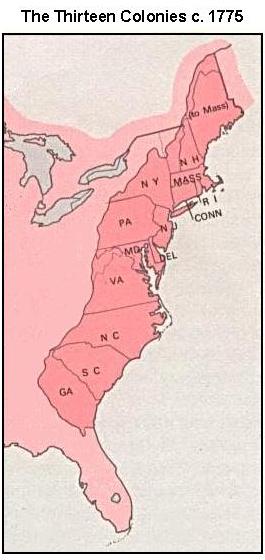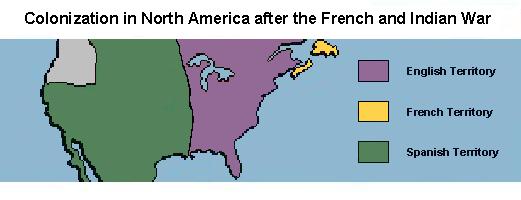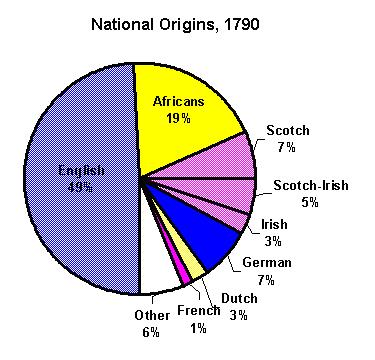A NEW WORLD (1000–1776)
European Discovery
Many people learned in school that Christopher Columbus discovered America in 1492. But actually America was discovered many times. The first people to come to North America were Asians who crossed the Bering Strait and entered Alaska at least 30,000 years ago. Over many centuries, they and their descendants spread across the Americas. These original Americans developed many cultures in the thousands of years that they controlled the land.
Europeans first came to North America around the year 1000. Vikings from northern Europe reached the eastern coast, but both disease and resistance from the native people drove them away. It is believed by many scientists and historians that some Vikings landed in the area where Massachusetts is located today. There are also remains of a Viking settlement at L'Anse Aux Meadow, in Newfoundland, Canada.
 One of the events that led to the next discovery of North America was the Crusades. During the 1100s and 1200s thousands of European Christians joined these holy wars to recapture Palestine from the Muslims. On the Crusades the Europeans bought new and exotic goods from the East, such as silk, spices, and precious jewels. As the demand for these goods grew, trade routes to Asia sprang up. Merchant ships departed from such Italian towns as Genoa and Venice, which soon became wealthy centers of business. The ships returned to Europe with new ideas as well as goods. In this way the Europeans' views of life began to change.
One of the events that led to the next discovery of North America was the Crusades. During the 1100s and 1200s thousands of European Christians joined these holy wars to recapture Palestine from the Muslims. On the Crusades the Europeans bought new and exotic goods from the East, such as silk, spices, and precious jewels. As the demand for these goods grew, trade routes to Asia sprang up. Merchant ships departed from such Italian towns as Genoa and Venice, which soon became wealthy centers of business. The ships returned to Europe with new ideas as well as goods. In this way the Europeans' views of life began to change.
This time period, known as the Renaissance, saw the rebirth of an interest in learning. Europeans developed a new spirit of discovery. Rulers wanted to find new water passages to Asia for their own countries because Italians controlled all the Mediterranean routes. Soon, Spain, Portugal, France, England, and Holland also began to search for new ocean routes.
This search paved the way for the "discovery" of North America by Christopher Columbus. Columbus knew that Earth was round, as did most educated people of the time, and believed that he could find a route to the East by sailing west from Europe. Backed financially by the king and queen of Spain, he sailed in 1492. He failed to reach the East because of a great landmass that lay in his way. Columbus had rediscovered North America. Because Columbus believed that he had sailed to India, he referred to the land as the "West Indies" and the natives he found as "Indians."
Back to Top
Colonization in North America
Columbus's discovery of America led to a period of European exploration and colonization. A country colonizes land when it sets up settlements, or colonies, or people and controls the economies and governments in them.
The Spaniards founded the first European colonies in America. When Columbus returned to Spain, he claimed that he had found the western route to the East. Many Spanish explorers sailed west expecting to find the rich spices and silks of Asia. Instead they found different kinds of wealth in a "New World."
Not all Spaniards who came to America were searching for instant riches. Many came to build homes and make new lives for themselves. Spanish colonies thrived in California and Florida as well as in Mexico, Central America, and South America.
 France, Holland, and England also sent explorers to America, but they didn't establish permanent colonies during the 1500s. French trappers traveled inland to trap otter and beaver for European markets. They also set up trading posts to buy furs from Native American trappers. France then sent explorers and colonists to claim and settle lands in North America. The city of Quebec became the center of their holdings in America.
France, Holland, and England also sent explorers to America, but they didn't establish permanent colonies during the 1500s. French trappers traveled inland to trap otter and beaver for European markets. They also set up trading posts to buy furs from Native American trappers. France then sent explorers and colonists to claim and settle lands in North America. The city of Quebec became the center of their holdings in America.
During the 1500s the Dutch sent fishing boats to North America. In 1609 Henry Hudson claimed for Holland the land along the river that still bears his name. Dutch farmers and merchants began settling along the Hudson River, and soon the port town of New Amsterdam was busy and prosperous. By 1664 England had forced Holland out of North America, and New Amsterdam was renamed New York.
In the late 1500s England made several unsuccessful attempts to start colonies. Finally, in 1607, a private company sent a group of about 100 English settlers. They landed in Virginia and named their settlement Jamestown after their king. At first the colonists spent more time looking for gold than planting crops. But under the leadership of Captain John Smith, Jamestown did survive.
In 1620 another group of English colonists known as the Pilgrims arrived. The Pilgrims weren't looking for riches; they wanted religious freedom. On the coast of New England they founded Plymouth Colony, which succeeded with farming advice from nearby Native Americans. Soon other English settlements grew up all along the eastern coast.
Back to Top
The Thirteen Original Colonies

Within a few years after Jamestown and Plymouth were settled, thousands more Europeans immigrated to England's colonies. They arrived in America seeking freedom from hunger, war, unemployment, or religious persecution. Others came from Africa, some as free people, but most as slaves.
The result of this mass immigration was the formation of the thirteen original colonies between 1620 and 1670. The climates and the land created a variety of economies and lifestyles. But the colonies fell into three general groups: the New England colonies (Massachusetts, Connecticut, Rhode Island, and New Hampshire), the middle colonies (New York, New Jersey, Pennsylvania, and Delaware), and the southern colonies (Maryland, Virginia, North Carolina, South Carolina, and Georgia).
In the New England colonies the rocky, infertile soil could not support large farms, so each tiny farm could provide just what each family needed. Life on such farms was difficult. Some New Englanders turned to the sea to become shipbuilders, fishers, and whalers.
The middle colonies had rich soil in rolling hills and fertile valleys. Farmers grew vegetables, fruit, and grain, and they could always count on a surplus. Thus they became commercial farmers and sold their extra crops. The middle colonies attracted many non-English settlers-Dutch, Germans, Scots, Irish, Swedes, and French.
Half of all the colonists lived in the five southern colonies. In 1613 a weed brought from the West Indies started the economy of Virginia moving. This weed-tobacco-quickly became the moneymaking crop of the southern colonies. Farmers were soon exporting rice and indigo along with tobacco. Large commercial growers needed cheap labor to make their farming profitable, and black Africans filled this need. While most southern farmers had medium-sized parcels of land and no slaves, prosperous planters had dozens of slaves.
Back to Top
The French and Indian War
During the 1700s Britain and France fought a number of wars on European soil. But the most important battles of their long struggle took place in America. The conflict between Britain and France in America was called the French and Indian War. It occurred because both countries claimed some of the same American land.
 British soldiers, American colonists, and some Native American tribes fought against French soldiers and France's many Indian allies. At first the British lost most of the battles. The French had learned to fight as the Native Americans did: they would sneak up for a surprise attack and then slip back into the woods. In the 1760s the British weren't prepared for this kind of warfare.
British soldiers, American colonists, and some Native American tribes fought against French soldiers and France's many Indian allies. At first the British lost most of the battles. The French had learned to fight as the Native Americans did: they would sneak up for a surprise attack and then slip back into the woods. In the 1760s the British weren't prepared for this kind of warfare.
As the conflict wore on, however, the British finally defeated the French. In 1763 England and France signed the Treaty of Paris. France had to give nearly all the land it claimed in North America to Britain. Spain, because it had supported France, had to give Florida to Britain.
Back to Top
Colonial Life
Ideas about democracy and equality lived and grew in the English colonies from the very beginning, although these ideas seldom applied to women, African Americans, and Native Americans. In Virginia in 1619 two white male colonists from each of Virginia's eleven communities met with the English governor in Jamestown. Together they made a number of laws for the colony. This group, called the House of Burgesses, was the first house of representatives in America.
 In New England, too, ideas of democracy developed early. Even before the Pilgrims left their ship, the Mayflower, they wrote an agreement known as the Mayflower Compact. This document outlined how all adult males would elect leaders and participate in the local government of their colony.
In New England, too, ideas of democracy developed early. Even before the Pilgrims left their ship, the Mayflower, they wrote an agreement known as the Mayflower Compact. This document outlined how all adult males would elect leaders and participate in the local government of their colony.
Each colony had a social class structure similar to those in Europe. At the top of society were large landowners, wealthy merchants, and shipping company owners. In the middle social class were shopkeepers, skilled crafts workers, and owners of medium-sized farms. At the bottom of the social structure were slaves, unskilled workers, and indentured servants. An indentured servant was a person, usually poor, who signed an agreement to work for a colonist for a certain period of time. In return, the colonist paid for the indentured servant's ship passage to America.
African Americans and women had few rights and opportunities. White males, however, had opportunities to climb the social ladder that often did not exist in Europe. Even some indentured servants worked out their contracts, saved money, and became wealthy landowners or businessmen.
In the early years of settlement, colonists thought of themselves as British, Dutch, or Germans living in a new land. Later their sons and daughters identified themselves by their colony—as Georgians, Pennsylvanians, or Rhode Islanders. Although most people probably did not think much about it, by the 1700s colonists from all different backgrounds were creating a new culture—an American culture.
Back to Top
 France, Holland, and England also sent explorers to America, but they didn't establish permanent colonies during the 1500s. French trappers traveled inland to trap otter and beaver for European markets. They also set up trading posts to buy furs from Native American trappers. France then sent explorers and colonists to claim and settle lands in North America. The city of Quebec became the center of their holdings in America.
France, Holland, and England also sent explorers to America, but they didn't establish permanent colonies during the 1500s. French trappers traveled inland to trap otter and beaver for European markets. They also set up trading posts to buy furs from Native American trappers. France then sent explorers and colonists to claim and settle lands in North America. The city of Quebec became the center of their holdings in America. One of the events that led to the next discovery of North America was the Crusades. During the 1100s and 1200s thousands of European Christians joined these holy wars to recapture Palestine from the Muslims. On the Crusades the Europeans bought new and exotic goods from the East, such as silk, spices, and precious jewels. As the demand for these goods grew, trade routes to Asia sprang up. Merchant ships departed from such Italian towns as Genoa and Venice, which soon became wealthy centers of business. The ships returned to Europe with new ideas as well as goods. In this way the Europeans' views of life began to change.
One of the events that led to the next discovery of North America was the Crusades. During the 1100s and 1200s thousands of European Christians joined these holy wars to recapture Palestine from the Muslims. On the Crusades the Europeans bought new and exotic goods from the East, such as silk, spices, and precious jewels. As the demand for these goods grew, trade routes to Asia sprang up. Merchant ships departed from such Italian towns as Genoa and Venice, which soon became wealthy centers of business. The ships returned to Europe with new ideas as well as goods. In this way the Europeans' views of life began to change.

 British soldiers, American colonists, and some Native American tribes fought against French soldiers and France's many Indian allies. At first the British lost most of the battles. The French had learned to fight as the Native Americans did: they would sneak up for a surprise attack and then slip back into the woods. In the 1760s the British weren't prepared for this kind of warfare.
British soldiers, American colonists, and some Native American tribes fought against French soldiers and France's many Indian allies. At first the British lost most of the battles. The French had learned to fight as the Native Americans did: they would sneak up for a surprise attack and then slip back into the woods. In the 1760s the British weren't prepared for this kind of warfare. In New England, too, ideas of democracy developed early. Even before the Pilgrims left their ship, the Mayflower, they wrote an agreement known as the Mayflower Compact. This document outlined how all adult males would elect leaders and participate in the local government of their colony.
In New England, too, ideas of democracy developed early. Even before the Pilgrims left their ship, the Mayflower, they wrote an agreement known as the Mayflower Compact. This document outlined how all adult males would elect leaders and participate in the local government of their colony.